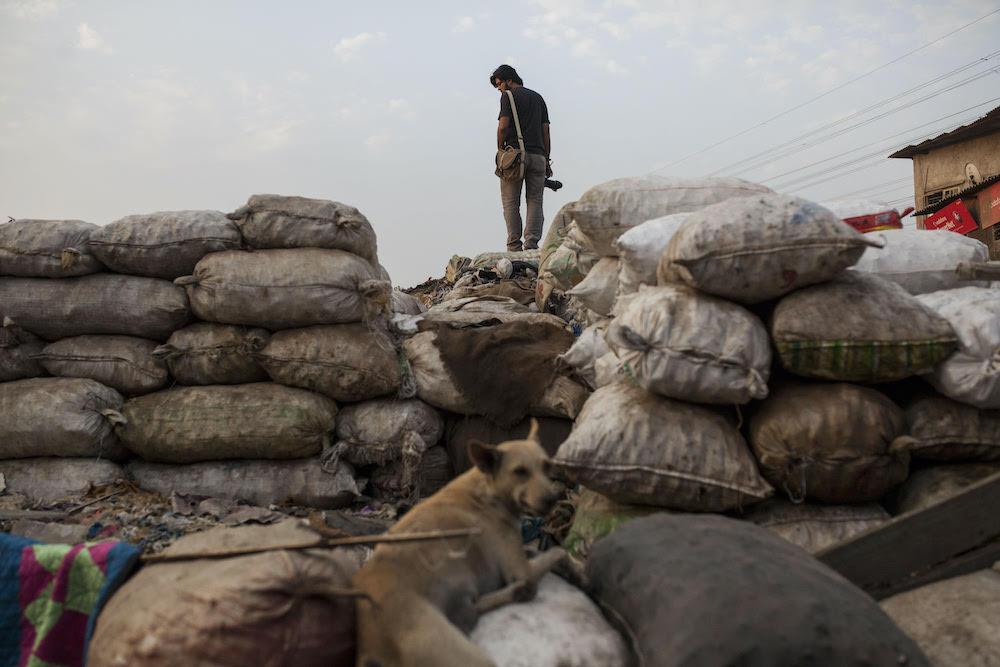The Image-Maker: Remembering Danish Siddiqui’s Eye for Detail

Danish Siddiqui shooting in Dharavi. (Mumbai, 2016. Image courtesy of Bernat Parera.)
As a conflict photographer, Danish Siddiqui was aware of the dangers attendant to his physical presence at the peripheries of volatile events. When he took the viral photograph of Mohammed Zubair being beaten up by a frenzied Hindu mob during the anti-Muslim pogrom in North-East Delhi in February 2020, Siddiqui’s protective gear was stained with the victim’s blood while poised in the vicinity. He just about managed to flee the site when the mob turned its attention to his camera. He undertook a similar risk to life in Spin Boldak, southern Kandahar, while documenting the Taliban offensive on the Afghan army in July 2021. Before losing his life at the hands of the former due to a miscalculated retreat, Siddiqui had taken a series of photographs while embedded with the armed forces―including a moment of rest when a soldier laid his ammunition aside to pray, in uniform, by a roadside. This quiet intimacy within (and despite) unrest characterises Siddiqui’s photographic oeuvre, which spans geographies, contexts and impulses. The running thread in his work is the stark visibilisation of that which institutions obliterate—thus foregrounding the fissures of the state, its claims and accountability to its peoples.
A trained drone pilot, Siddiqui’s overhead capture of a vast crematorium in Seemapuri, Delhi, became another defining image. It made evident the scale of deaths that occurred from state neglect during the second wave of the Covid-19 pandemic in April 2021. Resulting from an invisible affliction, the statistics were vastly downplayed by the incumbent Bharatiya Janata Party (BJP), as was the condition of a collapsing healthcare system. Siddiqui’s images of patients sharing oxygen cylinders, understaffed hospitals and masses of burning pyres helped inform a mass consciousness about the gravity of the disease unfolding in the city. These images, cumulatively, became a penetrating insight into not only the failures of an unresponsive government, but also the lies peddled by right-wing propagandists to control or dilute the intensity of the devastation. Siddiqui’s work gained momentum at a time when majoritarian politics saturated print and digital media (and still does), making his act of speaking truth to power a dangerous enterprise―a risk endemic to non-partisan journalism in the country. Siddiqui carried the risk in his surname itself, which further rendered him vulnerable to online abuse. Symptomatic of an Islamophobic temperament fostered by belligerent party leaders, the sentiment also carried parliamentary sanction―as evident in the discriminatory Citizenship Amendment Act (CAA) 2019. Siddiqui captured the mass protests against this legislation as well as the charged vocabularies of the moment.
Employed at Reuters, Siddiqui gained international recognition through the Pulitzer Prize for his coverage of the exodus of the marginalised Rohingya population from Myanmar to Bangladesh in 2018. One of the images captures a refugee momentarily savouring tactile contact with land after having made a long journey by the sea, as smoke billows from what used to be her homeland in the backdrop across the aqueous border. The image contains in its syntax a story that belongs to the subject in its entirety. Siddiqui’s gaze does not spectacularise, or minimise the subject to their conditions; it only arranges the elements in order that the image may be read for the human exhaustion it encapsulates. Siddiqui’s practice necessitates an understanding of the larger context and narrative-scape first. This drive frames the resulting image, imbuing it with empathy and protecting it against predatory dissemination. The virality of his images on social media platforms issues from the purpose they serve in filling the gaps in public knowledge, as they distill the distance between the story and the viewer.
Siddiqui’s photographs have acquired a certain iconicity. Through his lens, we have viewed political tensions in the Indian subcontinent uncoil over the past few years―whether it is the stooped gait of a fatigued health worker in a blue hazmat suit, or an X-ray sheet illuminating innumerable pellet injuries to a human skull in Kashmir, or the apathetic stance of the police body as a young man brandishes a gun at CAA protesters in Jantar Mantar. These images have circulated widely because they make legible instances of institutional abuse, foregrounding truth for posterity before it can be manipulated, denied or erased. Siddiqui’s work constitutes a visual archive of state violence perpetrated on vulnerable bodies, but not without its ethical imperative. He often spoke about the need to maintain a respectable distance from his subjects to avoid registering as intrusive, and even followed them outside the frame on occasion. For instance, he was relieved to find Zubair alive and convalescing in a local hospital, and took a portrait of his bandaged head as a document of his after-state. Siddiqui always emphasised wanting to capture the “…human face of a breaking story” and this image is perhaps the most literal affirmation of his claim.




